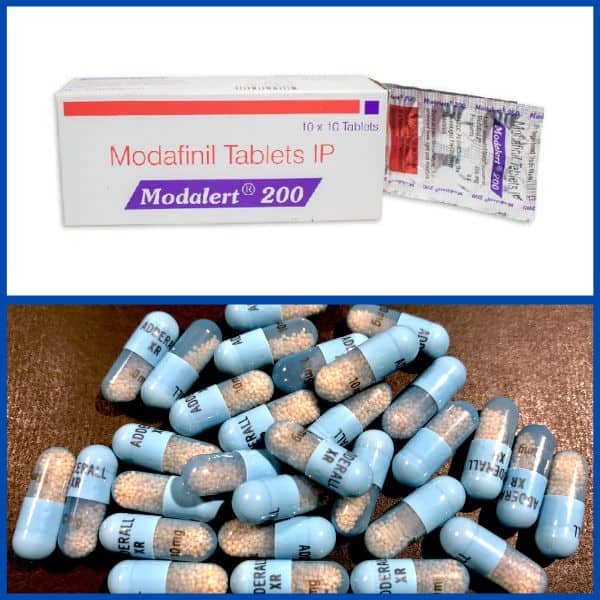

1. Introduction
Attention-Deficit/Hyperactivity Disorder (ADHD) is a neurodevelopmental disorder that affects a significant portion of the global population. While commonly diagnosed in childhood, ADHD often persists into adulthood, presenting challenges that can impact daily functioning. Over the years, a variety of treatments have been investigated for ADHD management, and Modafinil has been examined for its potential therapeutic benefits in this context.
2. What is Modafinil?
Modafinil, initially developed to address narcolepsy, functions as a wakefulness-promoting agent. Its mechanism of action, distinct from traditional stimulants, predominantly targets the neurotransmitter dopamine[1]Greenblatt, K., & Adams, N. (2023). Modafinil. In NCBI Bookshelf. Retrieved from https://www.ncbi.nlm.nih.gov/books/NBK531476/. While its primary indication is for sleep disorders, such as narcolepsy and obstructive sleep apnea, its off-label applications have garnered attention. One such application is its potential utility in ADHD management, given its cognitive enhancement properties without the pronounced side effects of standard stimulants. Furthermore, its potential for addiction and tolerance is considered to be relatively low, making it an option for consideration in long-term treatment plans.
3. Modafinil vs. Adderall

Both Modafinil and Adderall have been subjects of research for their potential efficacy in treating ADHD. They exhibit differences in mechanisms of action, side effect profiles, and regulatory classifications. Adderall, a combination of amphetamine salts, is an approved central nervous system stimulant for ADHD. It enhances the release of specific neurotransmitters, notably dopamine and norepinephrine[2]Heal, D. J., Smith, S. L., Gosden, J., & Nutt, D. J. (2013). Amphetamine, past and present – a pharmacological and clinical perspective. Journal of Psychopharmacology, 27(6), 479–496.. Its efficacy in managing ADHD is well-documented, but it also presents potential side effects and is classified as a Schedule II controlled substance. In contrast, Modafinil’s mechanism, while influencing dopamine, is unique. It modulates dopamine concentrations by inhibiting reuptake[3]Madras, B. K., Xie, Z., Lin, Z., Jassen, A., Panas, H., Lynch, L., … & Meltzer, P. C. (2006). Modafinil occupies dopamine and norepinephrine transporters in vivo and modulates the transporters and trace amine activity in vitro. Journal of Pharmacology and Experimental Therapeutics, 319(2), 561-569., and it’s classified as a Schedule IV controlled substance, indicating a comparatively lower potential for abuse.
4. Regulatory Views on Modafinil for ADHD: US FDA vs. Australia TGA
US Food and Drug Administration (FDA)
The FDA, responsible for safeguarding public health in the United States, has approved Modafinil for conditions including narcolepsy, obstructive sleep apnea, and shift work sleep disorder. Additionally, the FDA has granted Modafinil orphan drug status for the treatment of excessive daytime sleepiness associated with Parkinson’s disease and multiple sclerosis. However, despite these approvals, the FDA has not sanctioned Modafinil for ADHD treatment. This decision is rooted in concerns from clinical trials, notably potential severe skin reactions.
Therapeutic Goods Administration (TGA) of Australia
The TGA, Australia’s regulatory authority for therapeutic goods, has approved Modafinil for the treatment of narcolepsy, obstructive sleep apnea, and shift work sleep disorder. While Modafinil is available in Australia with a prescription, the TGA has expressed concerns about its off-label use as a ‘smart drug’ and warns against purchasing the drug online without a valid doctor’s prescription. The TGA emphasizes the potential health risks and legal implications associated with such actions. Furthermore, the TGA has a specific category for off-label use of medicines, termed “unapproved indications.” Modafinil is listed under this category for the treatment of ADHD, indicating its recognition but not explicit approval for this use.
In both regulatory contexts, while Modafinil has received approval for specific conditions, its use for ADHD remains off-label or under “unapproved indications,” underscoring the importance of thorough evaluation and consideration of potential risks and benefits.
5. Anecdotal Accounts
Clinical studies and trials provide structured and controlled data on a drug’s efficacy and safety. However, anecdotal accounts offer a different perspective, capturing the real-world experiences of individuals. Numerous individuals with ADHD have documented their experiences with Modafinil, providing insights into its potential advantages and limitations in a real-world setting.
Some individuals have reported enhanced focus, reduced impulsivity, and improved cognitive functions without the overstimulation often associated with traditional stimulants. Conversely, others have indicated experiencing side effects or a lack of efficacy in managing their ADHD symptoms. It’s important to consider that the effectiveness of Modafinil can be influenced by individual factors, such as metabolism, co-existing health conditions, and concomitant medications.
These personal accounts underscore the importance of a tailored approach to ADHD treatment, emphasizing the need for collaboration between the patient and the healthcare provider to determine the most suitable treatment strategy.
6. Side Effects of Modafinil
All pharmacological agents have associated side effects, and Modafinil is no exception. While many individuals tolerate the drug well, some common side effects have been reported, including headaches, nausea, and insomnia. More severe side effects, although rare, include:
- Skin Conditions: Instances of severe skin reactions, such as Stevens-Johnson syndrome, have been associated with Modafinil use[4]Prince, V., Philippidou, M., Walsh, S., & Creamer, D. (2018). Stevens-Johnson syndrome induced by modafinil. Clinical and Experimental Dermatology, 43(2), 191-192. https://doi.org/10.1111/ced.13282.
- Dependence: There is potential for Modafinil dependence, especially in populations with ADHD.
- Cardiovascular Effects: Some users may experience elevated blood pressure or heart rate.
- Mental Health Effects: Mood alterations, anxiety, and depression have been reported in some cases.
It’s imperative for individuals considering Modafinil for ADHD treatment to be informed about these side effects. A thorough consultation with healthcare professionals is essential to evaluate the potential risks and benefits.
7. Conclusion
The process of evaluating effective treatments for ADHD is intricate and requires a comprehensive analysis of available data. Modafinil has been identified as a potential therapeutic option based on its mechanism of action and side effect profile. Both the medical community and individuals with ADHD have shown interest in understanding its potential benefits and limitations.
However, as with all therapeutic agents, it’s essential to consider the associated benefits in conjunction with potential risks. The FDA’s position, combined with anecdotal accounts and clinical data, provides a comprehensive perspective on Modafinil’s potential role in ADHD treatment. While many individuals have reported positive outcomes, others may not derive the desired benefits or may experience side effects.
The verdict? While Modafinil presents a promising alternative for some individuals with ADHD, it is not a universally effective solution. Its potential as a treatment option varies based on individual factors, and a personalized approach, involving a thorough assessment and open dialogue with healthcare professionals, remains crucial for optimal treatment outcomes.
Buy Modafinil Online Review Comparison Table
| Product | Company | Quantity | Price | Country | Website |
 Modalert, Modvigil | ModafinilXL | 10 – 500 pills (100 & 200mg) | $29 – $599 |  AU, USA, Worldwide | Visit Website >> |
References
[+]
| ↑1 | Greenblatt, K., & Adams, N. (2023). Modafinil. In NCBI Bookshelf. Retrieved from https://www.ncbi.nlm.nih.gov/books/NBK531476/ |
|---|---|
| ↑2 | Heal, D. J., Smith, S. L., Gosden, J., & Nutt, D. J. (2013). Amphetamine, past and present – a pharmacological and clinical perspective. Journal of Psychopharmacology, 27(6), 479–496. |
| ↑3 | Madras, B. K., Xie, Z., Lin, Z., Jassen, A., Panas, H., Lynch, L., … & Meltzer, P. C. (2006). Modafinil occupies dopamine and norepinephrine transporters in vivo and modulates the transporters and trace amine activity in vitro. Journal of Pharmacology and Experimental Therapeutics, 319(2), 561-569. |
| ↑4 | Prince, V., Philippidou, M., Walsh, S., & Creamer, D. (2018). Stevens-Johnson syndrome induced by modafinil. Clinical and Experimental Dermatology, 43(2), 191-192. https://doi.org/10.1111/ced.13282 |

Leave a Reply